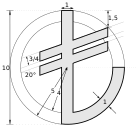Turkish lira
The Turkish lira (Turkish: Türk lirası; sign: ₺; code: TRY; usually abbreviated as TL)[3] is the currency of Turkey and the self-declared Turkish Republic of Northern Cyprus.
| Turkish lira | |
|---|---|
| Türk lirası (Turkish) | |
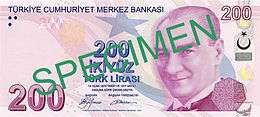 ₺200 banknote (obverse) | |
| ISO 4217 | |
| Code | TRY |
| Number | 949 |
| Exponent | 2 |
| Denominations | |
| Subunit | |
| 1⁄100 | |
| Plural | The language(s) of this currency do(es) not have a morphological plural distinction. |
| Symbol | ₺[1] TL |
| Banknotes | ₺5, ₺10, ₺20, ₺50, ₺100, ₺200 |
| Coins | 1kr, 5kr, 10kr, 25kr, 50kr, ₺1 |
| Demographics | |
| Official user(s) | |
| Unofficial user(s) | |
| Issuance | |
| Central bank | Central Bank of the Republic of Turkey |
| Website | www.tcmb.gov.tr |
| Printer | CBRT Banknote Printer |
| Website | www.tcmb.gov.tr |
| Mint | Turkish State Mint |
| Website | www.darphane.gov.tr |
| Valuation | |
| Inflation | 11.39% CPI (May 2020) |
| Source | Central Bank of the Republic of Turkey |
History
Ottoman lira (1844–1923)
The lira, along with the related currencies of Europe and the Middle East, has its roots in the ancient Roman unit of weight known as the libra which referred to the Troy pound of silver. The Roman libra adoption of the currency spread it throughout Europe and the Near East, where it continued to be used into medieval times. The Turkish lira, the French livre (until 1794), the Italian lira (until 2002), and the British pound (a translated version of the Roman libra; the word "pound" as a unit of weight is still abbreviated as "lb.") are the modern descendants of the ancient currency.
The Ottoman lira was introduced as the main unit of currency in 1844, with the former currency, kuruş, remaining as a 1⁄100 subdivision. The Ottoman lira remained in circulation until the end of 1927.[4]
First Turkish lira (1923–2005)
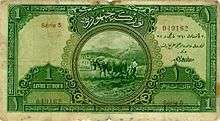
Historical banknotes from the second, third and fourth issues have portraits of İsmet İnönü on the obverse side. This change was done according to the 12 January 1926 issue of the official gazette[5][6] and canceled by the Democrat Party after World War II.
After periods of the lira pegged to the British pound and the French franc, a peg of 2.8 Turkish lira = 1 U.S. dollar was adopted in 1946 and maintained until 1960, when the currency was devalued to 9 Turkish lira = 1 dollar. From 1970, a series of hard, then soft pegs to the dollar operated as the value of the Turkish lira began to fall.
The following are based on yearly averages:
- 1960s – 1 U.S. dollar = 9 Turkish lira
- 1970 – 1 U.S. dollar = 11.3 Turkish lira
- 1975 – 1 U.S. dollar = 14.4 Turkish lira
- 1980 – 1 U.S. dollar = 80 Turkish lira
- 1985 – 1 U.S. dollar = 500 Turkish lira
- 1990 – 1 U.S. dollar = 2,500 Turkish lira
- 1995 – 1 U.S. dollar = 43,000 Turkish lira
- 2000 – 1 U.S. dollar = 620,000 Turkish lira
- 2001 - 1 U.S. dollar = 1,250,000 Turkish lira
The Guinness Book of Records ranked the Turkish lira as the world's least valuable currency in 1995 and 1996, and again from 1999 to 2004. The Turkish lira had slid in value so far that one original gold lira coin could be sold for 154,400,000 Turkish lira before the 2005 revaluation.
Second Turkish lira (2005–present)
In December 2003, the Grand National Assembly of Turkey passed a law that allowed for redenomination by the removal of six zeros from the Turkish lira, and the creation of a new currency. It was introduced on 1 January 2005, replacing the previous Turkish lira (which remained valid in circulation until the end of 2005) at a rate of 1 second Turkish lira (ISO 4217 code "TRY") = 1,000,000 first Turkish lira (ISO 4217 code "TRL"). With the revaluation of the Turkish lira, the Romanian leu (also revalued in July 2005) briefly became the world's least valued currency unit. At the same time, the Government introduced two new banknotes with the denominations of 50 and 100.
In the transition period between January 2005 and December 2008, the second Turkish lira was officially called Yeni Türk lirası ("New Turkish lira").[9] It was officially abbreviated "YTL" and subdivided into 100 new kuruş (yeni kuruş). Starting in January 2009, the "new" marking was removed from the second Turkish lira, its official name becoming just "Turkish lira" again, abbreviated "TL". All obverse sides of current banknotes have portraits of Mustafa Kemal Atatürk. Until 2016, the same held for the reverse sides of all current coins, but in 2016 one-lira coins were issued to commemorate the "martyrs and veterans" of the 2016 Turkish coup d'état attempt, the reverse sides of some of which depict hands holding up a Turkish flag while others show in stylized form a collection of five-pointed stars topped by a Turkish flag.[10]
Coins
From 1 January 2009, the phrase "new" was removed from the second Turkish lira, its official name in Turkey becoming just "Turkish lira" again;[11] new coins without the word "yeni" were introduced in denominations of 1, 5, 10, 25, 50 kuruş and 1 Turkish lira. Also, the center and ring alloys of the 50 kuruş and 1 Turkish lira coins were reversed.
| Current Turkish lira coins | ||||||||||||||
|---|---|---|---|---|---|---|---|---|---|---|---|---|---|---|
| Image | Value (kuruş) | Technical parameters | Description | Date of | ||||||||||
| Obverse | Reverse | Diameter (mm) | Thickness (mm) | Mass (g) | Composition | Edge | Obverse | Reverse | first minting | issue | ||||
| 1 | 16.5 | 1.35 | 2.2 | 70% Cu, 30% Zn | Plain | Value, Crescent-star, year of minting | Snowdrop | "TÜRKİYE CUMHURİYETİ", Mustafa Kemal Atatürk |
2008 | 1 January 2009 | ||||
| 5 | 17.5 | 1.65 | 2.9 | 65% Cu, 18% Ni, 17% Zn | Tree of life | |||||||||
| 10 | 18.5 | 3.15 | Rumi motif | |||||||||||
 |
 |
25 | 20.5 | 4 | Reeded | Kufic calligraphic | ||||||||
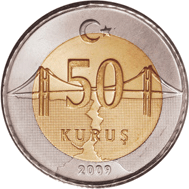 |
 |
50 | 23.85 | 1.9 | 6.8 | Ring: 65% Cu, 18% Ni, 17% Zn Center: 79% Cu, 17% Zn, 4% Ni |
Large reeded | Bosphorus Bridge and Istanbul silhouette | ||||||
 |
 |
100 (₺1) |
26.15 | 8.2 | Ring: 79% Cu, 17% Zn, 4% Ni Center: 65% Cu, 18% Ni, 17% Zn |
inscribed, T.C. letters and tulip figure | Rumi motif | |||||||
| These images are to scale at 2.5 pixels per millimetre. For table standards, see the coin specification table. | ||||||||||||||
Banknotes
A new series of banknotes, the "E-9 Emission Group" entered circulation on 1 January 2009, with the E-8 group ceasing to be valid after 31 December 2009 (although still redeemable at branches of the Central Bank until 31 December 2019). The E-9 banknotes refer to the currency as "Turkish lira" rather than "new Turkish lira" and include a new 200-Turkish-lira denomination.[12] The new banknotes have different sizes to prevent forgery.[13] The main specificity of this new series is that each denomination depicts a famous Turkish personality, rather than geographical sites and architectural features of Turkey.[14] The dominant color of the 5-Turkish-lira banknote has been determined as "purple" on the second series of the current banknotes.[15]
| Current Turkish lira banknotes 9. Emission Group | ||||||||||||
|---|---|---|---|---|---|---|---|---|---|---|---|---|
| Image | Value (₺) | Dimensions (mm) | Main Colour | Description | Date of issue | |||||||
| Obverse | Reverse | Obverse | Reverse | Watermark | ||||||||
| 5 | 130 × 64 | Brown | Mustafa Kemal Atatürk | Aydın Sayılı: solar system, atom, left-handed Z-DNA helix. |
Mustafa Kemal Atatürk, value | 1 January 2009 | ||||||
| Purple | 8 April 2013 | |||||||||||
| 10 | 136 × 64 | Red | Cahit Arf: Arf invariant, arithmetic series, abacus, binary sequence |
1 January 2009 | ||||||||
| 20 | 142 × 68 | Green | Architect Kemaleddin: Gazi University main building, aqueduct, circular motif and cube-globe-cylinder symbolizing architecture | |||||||||
| 50 | 148 × 68 | Orange | Fatma Aliye Topuz: flower and literary figures | |||||||||
 |
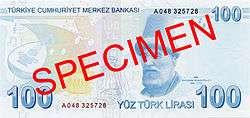 |
100 | 154 × 72 | Blue | Buhurizade Itri: musical notes, instruments and Mevlevi figure | |||||||
 |
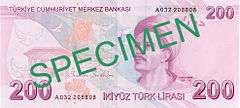 |
200 | 160 × 72 | Violet | Yunus Emre: Yunus's mausoleum, rose, pigeon and the line "Sevelim, sevilelim" (Let us love, let us be loved) | |||||||
| These images are to scale at 0.7 pixel per millimetre. For table standards, see the banknote specification table. | ||||||||||||
Exchange rates
| Year | 2005 | 2006 | 2007 | 2008 | 2009 | 2010 | 2011 | 2012 | 2013 | 2014 | 2015 | 2016 | 2017 | 2018 | 2019 | 2020-June |
|---|---|---|---|---|---|---|---|---|---|---|---|---|---|---|---|---|
| USD/TRY | 1.344 | 1.428 | 1.303 | 1.302 | 1.550 | 1.503 | 1.675 | 1.796 | 1.904 | 2.189 | 2.720 | 3.020 | 3.648 | 4.824 | 5.682 | 6.447 |

2018 crisis
In 2018, the lira's exchange rate accelerated deterioration, reaching a level of US$4.5/TRY by mid-May and of 4.9 a week later. Among economists, the accelerating loss of value was generally attributed to Recep Tayyip Erdoğan preventing the Central Bank of the Republic of Turkey from making the necessary interest rate adjustments.[18][19] Erdoğan, who claimed interest rates beyond his control to be "the mother and father of all evil", said that "the central bank can't take this independence and set aside the signals given by the president."[18] Despite Erdogan's apparent opposition, Turkey's Central Bank raised interest rates sharply.[20]
In the campaign for the 2018 general election in Turkey, a widespread conspiracy theory claimed that the Turkish lira's decline were the work of a shadowy group, made up of Americans, English, Dutch and "some Jewish families" who would want to deprive incumbent President Erdogan of support in the elections.[21] According to a poll from April 2018, 42 percent of Turks, and 59 percent of governing AK Party voters, saw the decline in the lira as a plot by foreign powers.[22] Turkish foreign minister Mevlüt Çavuşoğlu claimed Trump's wish to let the current US-Turkish tensions to drag on to the November 2018 US elections so to appeal to his Christian base and gain some points for his party.[23]
Currency sign
The current currency sign of Turkish lira was created by the Central Bank of the Republic of Turkey in 2012. The new sign was selected after a country-wide contest.[25] The new symbol, created by Tülay Lale, is composed of the letter 'L' shaped like a half anchor, and embedded double-striped letter 'T' angled at 20 degrees.
The design created by Tülay Lale was endorsed after a country-wide competition. It was chosen as the winner from a shortlist of seven submissions to the board of the Central Bank, selected from a total of 8,362 entries. The symbol resembles the first letter of the Turkish monetary unit L in the form of a half anchor with double stroke.[26][27][28][29][30]
Prime Minister Recep Tayyip Erdoğan announced the new symbol on 1 March 2012.[31] At its unveiling, Erdoğan explained the design as "the anchor shape hopes to convey that the currency is a 'safe harbor' while the upward-facing lines represent its rising prestige".[32]
Faik Öztrak, vice chairman of the main opposition party CHP, alleged that the new sign resembles the initials 'TE' of then-prime minister Tayyip Erdoğan in a reference to the tughra of Ottoman sultans.[33] The new Turkish lira sign was also criticized for allegedly showing a similarity with an upside-down Armenian dram sign.[30][34]
In May 2012, the Unicode Technical Committee accepted the encoding of a new character U+20BA ₺ TURKISH LIRA SIGN for the currency sign,[35] which was included in Unicode 6.2 released in September 2012.[36] On Microsoft Windows operating systems, when using Turkish-Q or Turkish-F keyboard layouts, it can be typed with the combination AltGr+T.
See also
- Banknotes of Turkey
- Coins of Turkey
- Economy of Turkey
- Economy of the Turkish Republic of Northern Cyprus
- Ottoman lira
- Turkish lira sign
| Current TRY exchange rates | |
|---|---|
| From Google Finance: | AUD CAD CHF EUR GBP HKD JPY USD RUB AZN |
| From Yahoo! Finance: | AUD CAD CHF EUR GBP HKD JPY USD RUB AZN |
| From XE.com: | AUD CAD CHF EUR GBP HKD JPY USD RUB AZN |
| From OANDA: | AUD CAD CHF EUR GBP HKD JPY USD RUB AZN |
| From fxtop.com: | AUD CAD CHF EUR GBP HKD JPY USD RUB AZN |
Notes
- Recognized only by Turkey
References
- "Turkish Lira Sign". Central Bank of the Republic of Turkey. Archived from the original on 13 December 2012. Retrieved 30 May 2013.
- "Falling lira hits Syrian enclave backed by Turkey". 28 August 2018 – via www.reuters.com.
- International Organization for Standardization. "Currency codes – ISO 4217". ISO. Retrieved 8 February 2013.
- "History of Paper Money". Central Bank of the Republic of Turkey. Archived from the original on 29 September 2013. Retrieved 8 February 2013.
- "701 Mevcûd Evrâk-ı Nakdiyyenin Yenileriyle İstibdâline Dâir Kânun" (PDF). Prime Ministry. Retrieved 8 February 2013.
- "Elyevm mevkii tedavülde bulunan evrakı nakdiye yerine, aynı evsafı kanuniyeyi haiz olmak ve aynı miktarda bulunmak üzere yeni evrakı nakdiye ihracı hakkında (1/750) numaralı kanun lâyihası ve Kavanin ve Muvazenei Maliye Encümenleri mazbataları" (PDF). Grand National Assembly of Turkey. Retrieved 8 February 2013.
- "Historical exchange rates from 1953 with graph and charts". fxtop.com.
- "Zoom on historical exchange rates graph". fxtop.com.
- Official Gazette of the Republic of Turkey. "Law on the Currency of the Republic of Turkey".
- "15 Temmuz şehit ve gazileri için hatıra para" [Commemorative money for martyrs and veterans of 15 July]. NTV. 31 October 2016. Retrieved 17 August 2017.
- "Public Announcement As to the Removal of the Prefix "New" From The New Turkish Lira". Archived from the original on 25 March 2008.
- Türkiye Cumhuriyet Merkez Bankasi (Central Bank of the Republic of Turkey) (8 May 2007). "Public Announcement As to the Removal of the Prefix "New" From The New Turkish Lira". Official Gazette. TCMB. p. 103. Archived from the original on 25 March 2008. Retrieved 5 January 2008.
- "TL banknotes to be in circulation in 2009". Turkish Daily News. 15 September 2006. Archived from the original on 30 September 2007. Retrieved 28 September 2006.
- "Türk Lirası'nda yeni yüzler". NTV-MSNBC (in Turkish). Anadolu Agency. 3 October 2008. Retrieved 22 March 2012.
- Türkiye Cumhuriyet Merkez Bankasi (Central Bank of the Republic of Turkey) (2 April 2013). "Press Release on the Issue of E-9 Emission Group II. Series Turkish Lira Banknotes". TCMB. Archived from the original on 29 September 2013. Retrieved 4 September 2013.
- "Exchange rates". OECD.
- "Yıllara Göre Ortalama Amerikan Doları Kuru Fiyatları, Ortalama USD Alış Satış".
- "Turkey's leader is helping to crash its currency". Washington Post. 16 May 2018.
- "Investors lose their appetite for Turkey". Financial Times. 16 May 2018.
- "Turkey's Central Bank Raises Interest Rates". The New York Times. Retrieved 13 September 2018.
- "Tumbling Turkish lira tests voters' support for Erdogan". Financial Times. 18 May 2018.
- "Forty-two percent of Turks say lira's drop is foreign plot". Ahval. 18 May 2018.
- "Trump wants row with Turkey to linger until US elections: Turkish FM - Turkey News". Hürriyet Daily News. Retrieved 14 October 2019.
- "TLSimge". Central Bank of the Republic of Turkey. Archived from the original on 24 February 2013. Retrieved 31 January 2013.
- "TL SİMGE YARIŞMASI ŞARTNAMESİ" (PDF) (in Turkish). Türkiye Cumhuriyeti Merkez Bankası. October 2011. Retrieved 9 September 2011.
- "TL Simgesi Açıklandı". TCMB Bülten, March 2012 (Vol. 25) (in Turkish). 1 March 2012. Archived from the original on 17 April 2012. Retrieved 1 March 2012., page 6.
- "Başkan Başçı'nın TL Simge Yarışması Basın Toplantısında Yaptığı Konuşma" (in Turkish). Türkiye Cumhuriyet Merkez Bankası. Archived from the original on 3 March 2012. Retrieved 1 March 2012.
- "Türk lirasının yeni simgesi açıklandı". Haber 7 (in Turkish). Retrieved 4 March 2012.
- "Brand new Turkish Lira sign revealed". Hürriyet Daily News. 1 March 2012. Retrieved 4 March 2012.
- "Dünyada TL kullanımı 3'e katlandı, 'çıpa'lı simge 'güvenli liman' mesajı oldu". Hürriyet (in Turkish). 2 March 2012. Retrieved 4 March 2012.
- "PM Erdoğan announces symbol for Turkish lira", TodaysZaman.com, 1 March 2012
- "Turkey unveils symbol for national currency", TodaysZaman.com, 1 March 2012
- "CHP'den, TL simgesi için ilginç iddia". Hürriyet (in Turkish). 1 March 2012. Retrieved 4 March 2012.
- "Paramızın artık haysiyeti var faizlerin daha da inmesi lazım". Hürriyet (in Turkish). 2 March 2012. Retrieved 4 March 2012.
- "Unicode 6.2 to Support the Turkish Lira Sign from announcements_at_unicode.org on 15 May 2012 (Unicode Mail List Archive)". Unicode.org. 15 May 2012. Retrieved 31 January 2013.
- "Unicode 6.2.0". The Unicode Consortium. 23 October 2012.
Further reading
- Krause, Chester L.; Clifford Mishler (1991). Standard Catalog of World Coins: 1801–1991 (18th ed.). Krause Publications. ISBN 0873411501.
- Pick, Albert (1994). Standard Catalog of World Paper Money: General Issues. Colin R. Bruce II and Neil Shafer (editors) (7th ed.). Krause Publications. ISBN 0-87341-207-9.
- Sevket Pamuk (2000). A Monetary History of the Ottoman Empire. Cambridge University Press. ISBN 0-521-44197-8.
External links
![]()
- Turkish Central Bank (Banknote Museum page)
- TL Simge Turkish lira sign page of the Central Bank of the Republic of Turkey website
- Detailed information on the Turkish lira banknotes and coins in circulation since 2009
- Turk Numismatics
- Turkish Lira Today
- Turkey Banknotes Catalog | Turkish Lira since 1923
- Historical and current banknotes of Turkey (in English, German, and French)

